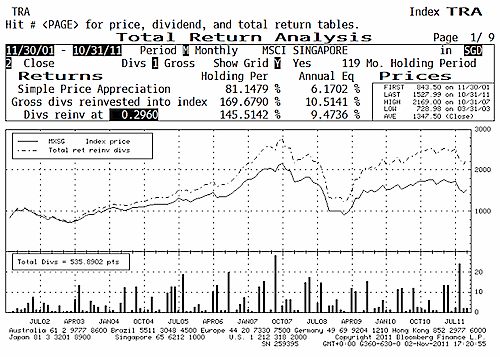Singapore dividend stocks are one of the underappreciated gems of investing in Asia.
The Singapore market has a strong income culture, with most firms paying out dividends from relatively early on. It’s also generally seen as less glamorous than neighbouring markets and tends to trade on lower valuations. As a result, you can often buy into very solid companies at surprisingly high yields.
Take a look at the chart below, which shows the performance of the MSCI Singapore index over the last decade. You can see how large a contribution income made to returns from Singapore stocks.
Price return alone has been 81%, or about 6% per year – respectable given what’s happened in the last 10 years. But receiving and reinvesting dividends more than doubled the cumulative return to 170% or 10.5% per year.
For foreign investors, this becomes very attractive. Like most Asian currencies, the Singapore dollar is likely to rise against the US dollar, sterling and the euro in the long run. Combine currency appreciation with good starting yields and steady growth, and you could be looking at regular double-digit payouts on your initial investment in a few years.
Where to look for income stocks in Singapore
One place to look is the real estate investment trust (Reit) sector, which tends to be a popular choice for local income seekers. This has a number of high-quality relatively secure Reits on decent yields.
Some candidates among the larger Reits include Ascendas Reit, which holds mostly industrial properties, on a trailing yield of 6.5%. Serviced apartment investor Ascott Residence Trust is on 7.4%, Suntec Reit, owner of the eponymous office and retail complex, yields 8.4%, and CapitaCommercial Trust, another office and retail fund, is on 6.8%. Among the smaller ones, I especially like First Reit, which owns healthcare properties in Indonesia, and yields 8.6%.
Singapore Reits were an extremely good buy during the worst of the global financial crisis in late 2008 and early 2009. Fears over refinancing risks were so great that many were trading on yields of around 15% or higher.
But the same hasn’t happened this time. Most of the good-quality S-Reits haven’t fallen much over the last year. Investors remain keen on them for defensive income.
Right now, I think there are better buying opportunities in Singaporean blue chips, many of which yield 3.5-5.5% and are extremely solid. There’s more dividend growth potential in some of these stocks, whereas organic growth potential in a Reit is usually limited. So the names below are five of my favourite Singapore stocks for income buyers at the moment.
This isn’t a highest yielders list, but more a balance of yield, security and growth prospects. Singaporean investors wouldn’t consider all of these to be income plays by local standards. But for foreign investors looking to buy good quality Singaporean stocks with decent dividends, these would make very sound core holdings.
I’ve limited the list to an S$1bn-plus market cap. There are some excellent growth and income prospects among smaller firms, but for this list I’m looking for the most solid and reliable firms.
Five solid Singapore dividend stocks
1) The obvious first candidate for a Singapore income portfolio is Singapore Telecommunications. This is the largest stock by market cap on the Singapore exchange and the leading local telecoms group, with investments in a number of other markets as well.
SingTel is currently on a trailing yield of 5%. The dividend should grow in the years ahead, especially if its overseas investments start to perform. Like many multinational telcos, this part of the business has been disappointing so far, but cut-throat competition in major growth markets such as India should settle down in the years ahead.
2) Stock and derivative operator Singapore Exchange is a straightforward story. If you believe that Asian financial markets will continue growing strongly in the years ahead and Singapore will remain a key financial sector, this stock is the way to invest in that growth. A yield of 4.2% seems a good payout for this potential.
3) I’m also keen on Overseas Chinese Banking Corporation (OCBC), one of the best banks in Asian. The firm has good growth prospects regionally, in retail and commercial banking, in private banking and in wealth management and investment services. A yield of 3.7% isn’t exceptionally high by itself, but becomes much more attractive in that context.
4) I have an overwhelming aversion to the aviation business due to its long record of destroying shareholder value, but Singapore Airlines is a remarkably competent firm in a terrible sector. The group remained profitable and dividend paying even in 2009-2010 while dealing with the global crisis.
The current trailing yield is 5.3%. Obviously, dividends won’t stay constant through the cycle in the same way as some of the more defensive stocks on this list, but if bought at the right time Singapore Airlines should give you a decent income and decent capital gains over time.
The firm’s maintenance arm SIA Engineering and terminal services business SATS are separately listed and offer decent yields in their own right (5.4% and 4.7% respectively). Earnings and dividends are much more stable at these parts of the business and they would be a more conservative choice. But right now, the parent has sold off more than either subsidiary and is almost back to its crisis lows, so probably offers the better buying opportunity.
5) Lastly, aerospace and defence is always a good place to look for solid income, and local heavyweight Singapore Technologies Engineering doesn’t disappoint. It’s on a trailing yield of 5.1% and should be able to continue to growing this in a steady, if unexciting, way over the long term.
I was going to wrap this up by including a full table of high yield Singapore stocks for anyone who wants to investigate other possibilities, but another site got there first. See the very handy Singapore dividend stocks screener on the Investment Moats blog for more ideas.
